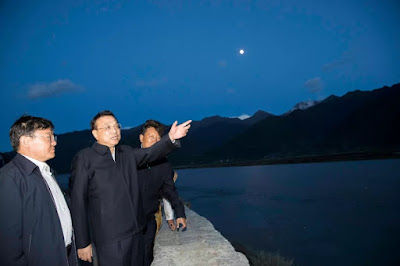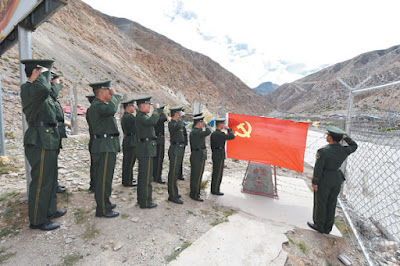 |
| "Tibetans shall be happy in the land of Tibet, and Chinese in the land of China" says the Treaty of 821 |
Remember after the Two Meetings in March, China decided to unify its Voice.
A document of the State Council released on March 21, announced that Beijing had decided to form the world’s largest media group called Voice of China.
It was to combine the existing China Central Television, China National Radio, and China Radio International under one unified umbrella and name.
The Publicity Department was to manage it with the responsibility to “promote the Party theory and guidelines, organize major publicity and coverage, guide social hot topics, strengthen international communication capabilities, and publish positive news on China.”
Voice of China was to produce the Party’s propaganda program, copying the model of stations in foreign countries working with government funding using limited amount of advertising.
The website Chinascope observed that “China Central Television has at least 10,000 employees with over 70 branch stations overseas. China National Radio has over 2,100 employees and China Radio International has over 2,000 employees and broadcasts in over 60 languages.”
Following the consolidation, Voice of China was to become world’s largest media.
Well, it is not yet in place.
China spoke with two voices on Premier Li Keqiang in Tibet.
The coverage of the visit was interesting in this respect.
While some local websites mentioned the visit to Nyingchi and next day to Lhasa (Jokhang), most of the main Chinese-language media has not covered the visit as yet.
But there is an exception, the website of the State Council (Li is the Premier of the State Council).
It looks like that while the media affiliated to the State Council have covered it and it is not the case of the Party media. Two Voices?
Does this have an implication on the stability of the Middle Kingdom?
Worth watching.
Another issue
Another topic that I partially discussed in my previous post, why was Li delegated to ‘inspect’ Tibet?
My guess is that President Xi needs to be released from some of his duties/burdens.
Too many are presently gunning for him (including President Trump).
He needs to share more with Li.
It might be an explanation.
Meeting the Defense Forces?
So far, the State Council has not published any pictures or reports of Premier Li with the PLA/PAP/Border Forces.
Customarily during such a visit, the leader from Beijing should ‘congratulate’ the Forces for their ‘excellent’ job, while giving a lecture on the importance to secure the borders and promoting the ‘fusion’ with the local population.
Why was it not done?
It is possible that Li was told that it was not his job. But that would be surprising.
We may know more in a few days, when the main media will cover the visit (once Li is back home).
The Importance of Environment
On the first day, Premier Li Keqiang spoke of the importance of the Qinghai-Tibet Plateau which is ecologically fragile, but has important water resources, “so more efforts should be spent to make it an ecological model,” said Li.
He was inspecting the confluence of the Yarlung Tsangpo River and Nyang River, not far from Bayi, the main garrison near the Indian border.
The Nyang chu is the main tributary of the Yarlung Tsangpo.
Li urged the local government to construct Tibet into a beautiful place.
Random Shopping
He also ‘randomly’ visited a local store in Nyingchi and did some shopping.
When the owner of the store explained to the Premier about local food, such as Tibetan butter tea and sweet tea, which are popular among both local Tibetans and Chinese tourists, Li took his wallet out and bought one box of butter tea and one box of sweet tea for 116 yuan (US $17), at the ‘displayed price’ said the article.
No discount for the Premier!!
Li said that he hoped that more Tibetan products could be sold across China and all over the world.
Visit to Jokhang Cathedral
The atheist Premier also went to the Jokhang Cathedral in Lhasa.
An article observed: ‘Premier Li Keqiang visited Tibetan religious patriots at Jokhang Temple and extended his sincere greetings and best wishes on July 26.”
It added: “Built in ancient Tibetan times, Jokhang Temple was the holy hall of Tibetan Buddhism and a witness to the peacemaking marriage between Han and Tibetan ethnic groups and to the history of ethnic solidarity”.
Premier Li hoped that “Tibetan religious patriots could learn from the eminent monks in history, and devote themselves to maintaining the unity of the state, ethnic solidarity, a harmonious society and smooth religious affairs.”
He wished “religious patriots good health and good luck in everything.”
The Dalai Lama is obviously not included in the ‘patriots’.
While at Jokhang, Li affirmed that he believed that "religious circles will continue to make contributions in safeguarding national unity and promoting ethnic solidarity as well as social harmony."
The Treaty of 821 AD
Another report mentioned the visit to the Stone Pillar ('doring’ in Tibetan, see picture above) near the Central Cathedral. Li cited this as a model for the unity between the Tibetans and the Chinese.
The Treaty of 821 AD is engraved on the famous Stone Pillar.
Li probably did not read the text of the Treaty (see my post on the subject, Tibetans shall be happy in the land of Tibet and Chinese in the land of China?
Tibet and China shall abide by the frontiers of which they are now in occupation. All to the east is the country of Great China; and all to the west is, without question, the country of Great Tibet. Henceforth on neither side shall there be waging of war nor seizing of territory. If any person incurs suspicion he shall be arrested; his business shall be inquired into and he shall he escorted back.Li visited a Hospital in Lhasa. He promised that Beijing would step up its support to hospitals and colleges of traditional Tibetan medicine, to meet the needs of local residents.
…Tibetans shall be happy in the land of Tibet, and Chinese in the land of China. Even the frontier guards shall have no anxiety, nor fear and shall enjoy land and bed at their ease.
In Lhasa, Li also interacted with youngsters at a location dedicated to startups.
The Premier observed that entrepreneurship and innovation were important for a high-quality growth: "The country will create better environment to support the education of skilled workers and train more talented workers that are in high demand," he said.
At the Potala Palace, a UNESCO world heritage site, Li promised that the government's support for "research on precious documents and to push cultural inheritance and exchanges."
How this will translate concretely is not clear.
The Gang of Five
Incidentally, Li met with the Gang of Five, the hard core Old Guard (Raidi, Phakpala, Jampa Phuntsok, Legchok and Pasang). He praised the work that they have done in the past for the stability of Tibet.
The State Council website noted that on the afternoon of July 26, Premier Li Keqiang met with senior and retired Tibetan officials in Lhasa: “Premier Li affirmed the officials’ important contributions to the development and stability of Tibet, and extended greetings to them on behalf of the CPC Central Committee and the State Council. He also wished them a happy and healthy life, and the long-term steady development of Tibet.”
Why did Li needed to meet them together?
Does Beijing want to return to the ‘Old Tibet Spirit’ of the first Communists?
Once again, no answer.
And there is no news of a meeting with the Chinese Panchen Lama, Gyatsen Norbu.
 |
| On the Roofs of the Jokhang |
 |
| From the roofs of Jokhang |
 |
| Meeting old officials |
 |
| Meeting the monks in Jokhang |
 |
| Inspecting the new Railway line Lhasa-Nyingchi |
 |
| Spending 116 Yuans |
 |
| Inspecting the railway work |
 |
| Full moon night at the confluence of the Yarlung Tangpo and the Nyang |





























